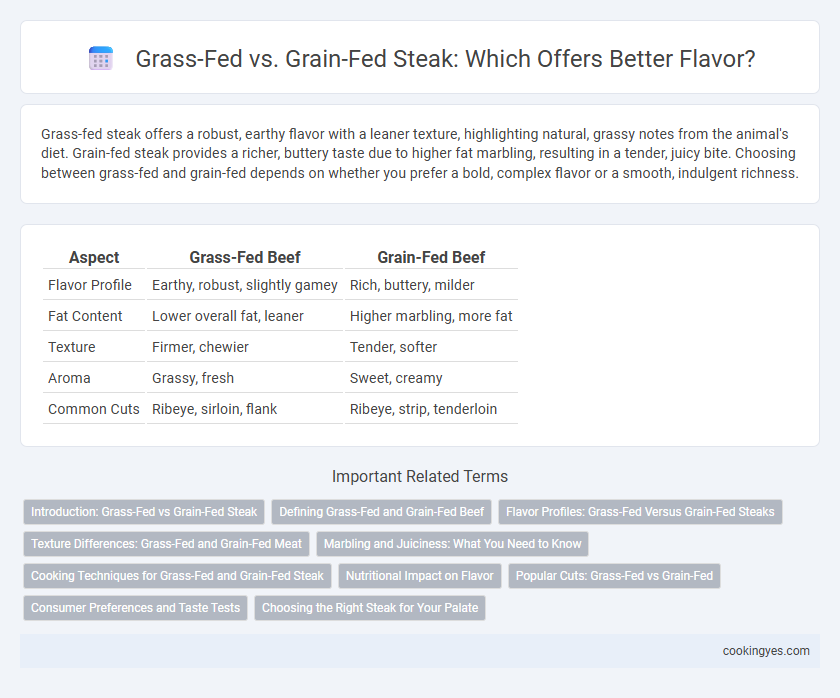Grass-fed steak offers a robust, earthy flavor with a leaner texture, highlighting natural, grassy notes from the animal's diet. Grain-fed steak provides a richer, buttery taste due to higher fat marbling, resulting in a tender, juicy bite. Choosing between grass-fed and grain-fed depends on whether you prefer a bold, complex flavor or a smooth, indulgent richness.
Table of Comparison
| Aspect | Grass-Fed Beef | Grain-Fed Beef |
|---|---|---|
| Flavor Profile | Earthy, robust, slightly gamey | Rich, buttery, milder |
| Fat Content | Lower overall fat, leaner | Higher marbling, more fat |
| Texture | Firmer, chewier | Tender, softer |
| Aroma | Grassy, fresh | Sweet, creamy |
| Common Cuts | Ribeye, sirloin, flank | Ribeye, strip, tenderloin |
Introduction: Grass-Fed vs Grain-Fed Steak
Grass-fed steak offers a distinctive, robust flavor profile often described as earthy and gamey, reflecting the natural diet of cows grazing on pasture. Grain-fed steak tends to have a richer, buttery taste with increased marbling, contributing to tenderness and juiciness. The choice between grass-fed and grain-fed influences texture, fat content, and nutritional composition, shaping the overall flavor experience.
Defining Grass-Fed and Grain-Fed Beef
Grass-fed beef comes from cattle that graze on natural pastures, resulting in a leaner meat with a distinct, earthy flavor rich in omega-3 fatty acids and antioxidants. Grain-fed beef is produced from cattle finished on a diet of corn and other grains, yielding a marbled texture and a sweeter, buttery taste due to higher fat content. Understanding these feeding practices is essential for discerning the flavor profile and nutritional differences between the two types of steak.
Flavor Profiles: Grass-Fed Versus Grain-Fed Steaks
Grass-fed steaks offer a robust, earthy flavor with a leaner texture, rich in omega-3 fatty acids and antioxidants that enhance a natural, grassy aroma. Grain-fed steaks tend to have a milder, buttery taste with higher marbling and fat content, contributing to a tender, juicy bite and a slightly sweet, caramelized finish. Flavor profiles vary significantly due to diet, impacting the steak's overall taste, texture, and nutritional composition.
Texture Differences: Grass-Fed and Grain-Fed Meat
Grass-fed steak typically features a leaner texture with a firmer bite due to the animal's natural diet and higher muscle activity, offering a more fibrous and sometimes chewier mouthfeel. Grain-fed steak, in contrast, is characterized by a higher fat marbling that results in a tender, buttery texture with a smoother, more velvety sensation on the palate. These textural differences influence cooking methods, with grass-fed requiring careful heat control to avoid toughness, while grain-fed steaks generally tolerate higher temperatures for enhanced juiciness.
Marbling and Juiciness: What You Need to Know
Grass-fed beef offers a leaner profile with a robust, earthy flavor, while grain-fed beef is known for superior marbling that enhances juiciness and tenderness. Marbling, the intramuscular fat visible in grain-fed steaks, directly influences the rich mouthfeel and buttery texture prized by steak connoisseurs. Understanding the balance between marbling and natural juiciness helps determine whether grass-fed or grain-fed steak better suits your flavor preference and cooking method.
Cooking Techniques for Grass-Fed and Grain-Fed Steak
Grass-fed steak, known for its lean texture and robust, earthy flavor, benefits from slow, low-temperature cooking methods like sous vide or reverse searing to retain moisture and tenderness. Grain-fed steak, with its higher marbling and buttery taste, excels when cooked quickly over high heat using techniques such as grilling or pan-searing to develop a caramelized crust and juicy interior. Understanding the fat content and muscle composition of each type guides optimal cooking temperatures and times for enhanced flavor and texture.
Nutritional Impact on Flavor
Grass-fed steak offers a distinct flavor profile characterized by a leaner texture and a slightly grassy, earthy taste due to higher omega-3 fatty acids and antioxidants like vitamin E. Grain-fed steak tends to have a richer marbling with increased intramuscular fat, resulting in a buttery, tender flavor enhanced by higher levels of saturated fat and omega-6 fatty acids. Nutritionally, the balance of healthier fats in grass-fed beef can influence flavor complexity, while grain-fed beef delivers a consistent, savory taste preferred for its juiciness and richness.
Popular Cuts: Grass-Fed vs Grain-Fed
Grass-fed steak offers a distinct, robust flavor profile with a leaner texture that appeals to health-conscious consumers seeking natural taste. Popular cuts like ribeye and sirloin from grass-fed cattle tend to have a slightly gamey, earthy flavor with firmer muscle fibers. Grain-fed steak, especially well-marbled ribeye and striploin, delivers a richer, buttery taste and tender texture favored by those preferring a more indulgent dining experience.
Consumer Preferences and Taste Tests
Grass-fed steak offers a distinct, robust flavor characterized by earthy and grassy notes, favored by consumers seeking natural and lean meat options. Grain-fed steak is preferred for its rich marbling and buttery, tender texture, often scoring higher in taste tests for juiciness and mild sweetness. Consumer preferences frequently hinge on flavor intensity and texture, with taste tests revealing a split favoring grain-fed for softness and grass-fed for intensity.
Choosing the Right Steak for Your Palate
Grass-fed steak offers a leaner texture with a robust, earthy flavor favored by those seeking a natural, slightly gamey taste. Grain-fed steak provides a richer, buttery profile due to higher marbling, appealing to palates that prefer tender, juicy beef. Selecting the right steak depends on whether you prioritize boldness or tenderness in your flavor experience.
Grass-fed vs Grain-fed for flavor Infographic

 cookingyes.com
cookingyes.com